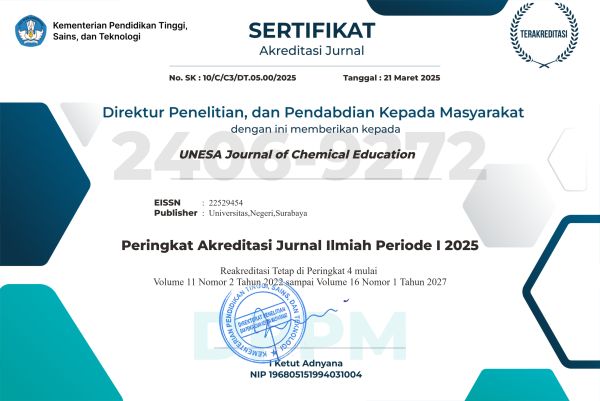ANALYSIS OF MULTIPLE REPRESENTATION ABILITIES OF MALE AND FEMALE GRADE STUDENT AT SMAN 1 TANJUNGANOM IN ACID-BASE MATERIAL
DOI:
https://doi.org/10.26740/ujced.v13n1.p52-59Keywords:
multiple representations, acid-base, DAC framework, gender differencesAbstract
The field of chemistry has become one of the abstract sciences, particularly in the context of acid-base materials, thus requiring the integration of multiple representations. Incomplete multiple representation abilities in students can lead to difficulties in understanding acid-base materials. Therefore, this research aims to analyze (1) the level of students' multiple representation abilities in acid-base materials and (2) the differences in the levels of multiple representation abilities between male and female students. The research method used is a comparative ex-post facto approach with a quantitative approach. The research instruments include test questions based on the DAC framework and interview sheets. The results of this research are as follows: (1) the average level of multiple representation abilities is 20%, categorized as very poor. The percentages of multiple representation abilities based on the DAC framework are 29% for definition, 18% for algorithmic, and 20% for conceptual. The highest percentage in the DAC framework indicators is D-R at 32%, while the lowest percentage is C-O at 11%. (2) There is a difference in the levels of multiple representation abilities between male and female students, as evidenced by the results of the Mann-Whitney U test, with an Asymp. Sig. (2-tailed) value of 0.000 ≤ 0.05.
Downloads
References
Alighiri, D. Drastisianti, A., and Susilaningsih, E. 2018. Pemahaman Konsep Siswa Materi Larutan Penyangga Dalam Pembelajaran Multiple Representasi. Jurnal Inovasi Pendidikan Kimia, Vol 12, No 2, pp. 2192‒2200.
Ardhana, I. A. 2020. Dampak Process-Oriented Guided-Inquiry Learning (POGIL) terhadap Pengetahuan Metakognitif Siswa pada Topik Asam-Basa. Hydrogen:Jurnal Kependidikan Kimia, Vol 8, No 1, pp. 1–10.
Parniyanda, F. and Sukarmin. 2022. Pengembangan Software Anti MISCHEMistry dengan Menggunakan Strategi Conceptual Change Text Untuk Mereduksi Miskonsepsi Siswa pada Materi Asam Basa. UNESA Journal of Chemical Education, Vol 11, No 2, pp. 87–94.
Utami, I., Mulyani, B., and Yamtinah, S. 2020. Identifikasi Miskonsepsi Asam-basa dengan Two Tier Multiple Choice Dilengkapi Interview. Jurnal Pendidikan Kimia, Vol 9, No 1, pp. 89–97.
Nilawati, P. A., Subandi, and Utomo, Y. 2016. Keefektifan Pembelajaran Interkoneksi Multipel Representasi dalam Mengurangi Kesalahan Konsep Siswa pada Materi Stokiometri. Jurnal Pendidikan: Teori, Penelitian, dan Pengembangan, Vol 1, No 11, pp. 2076–2082.
Syahri, W. and Yusnadar, Y. 2022. Pengembangan E-Book Materi Gas Ideal Berbasis Multipel Representasi Menggunakan 3D Pageflip. Journal of The Indonesian Society of Integrated Chemistry, Vol 14, No 1, pp. 1–9.
Andromeda, B., Djudin, T., and Maria S., H. T. 2017. Analisis Kemampuan Multirepresentasi Siswa pada Konsep-konsep Gaya di Kelas X SMA Neegeri 3 Pontianak. Jurnal Pendidikan dan Pembelajaran Khatulistiwa (JPPK), Vol 6, No 10, pp. 1–16.
Karlina, A. 2022. Profil Kemampuan Pemecahan Masalah Matematika Ditinjau Dari Gaya Kognitif Siswa. Jurnal Math-UMB.EDU, Vol 9, No 3, pp. 149–155.
Imamuddin, M. and Isnaniah, I. 2018. Profil Kemampuan Spasial Mahasiswa Camper Dalam Merekonstruksi Irisan Prisma Ditinjau Dari Perbedaan Gender. Jurnal Matematika dan Pembelajaran, Vol 6, No 1, pp. 31–39.
Smith, K. C., Nakhleh, M. B., and Bretz, S. L. 2010. An expanded framework for analyzing general chemistry exams. Chemistry Education Research and Practice, Vol 11, No 3, pp. 147–153.
Helsy, I. and Andriyani, L. 2017. Pengembangan Bahan Ajar Pada Materi Kesetimbangan Kimia Berorientasi Multipel Representasi Kimia. JTK (Jurnal Tadris Kimiya), Vol 2, No 1, pp. 104–108.
Abbott, M. L. 2011. Understanding Educational Statistics Using Microsoft Excel and SPSS. Canada: Wiley.
Zahro’, S. F. and Ismono. 2021. Analisis Kemampuan Multirepresentasi Siswa Pada Materi Kesetimbangan Kimia di Masa Pandemi Covid-19. Chemistry Education Practice, Vol 4, No 1, pp. 30–39.
Safitri, L., Winarti, A., and Suharto, B. 2020. Analisis Pemahaman Konsep Makroskopik-Submikroskopik-Simbolik Menggunakan Pendekatan Submikroskopik Pada Materi Larutan Asam Basa. JCAE (Journal of Chemistry And Education), Vol 4, No 1, pp. 16–23.
Sunyono, Yuanita, L., and Ibrahim, M. 2013. Efektivitas Model Pembelajaran Berbasis Multipel Representasi dalam Membangun Model Mental Mahasiswa Topik Stoikiometri Reaksi. Pendidikan Progresif, Vol 3, No 1, pp. 65–79.
Azizah, N. L., Mahardiani, L., and Yamtinah, S. 2022. Analisis Miskonsepsi Dengan Tes Diagnostik Two-Tier Multiple Choice Dan in-Depth Interview Pada Materi Asam Basa. Jurnal Pendidikan Kimia, Vol 11, No 2, pp. 168–177.
Fajrin, S., Haetami, A., and Marhadi, M. A. 2020. Identifikasi Kesulitan Belajar Kimia Siswa Pada Materi Pokok Larutan Asam Dan Basa Di Kelas Xi Ipa2 Sma Negeri 1 Wolowa Kabupaten Buton. Jurnal Pendidikan Kimia FKIP Universitas Halu Oleo, Vol 5, No 1, pp. 27–34.
Gilbert, J. K. and Treagust, D. 2009. Multiple Representation in Chemical Education. Netherlands: Springer Dordrecht.
Sarastuti, R. D., Hambali, H., and Separen. 2022. Studi Komparatif Karakter Kreatif Pembelajaran Online Mata Pelajaran PKn Antara Siswa Laki-laki dan Perempuan di SMA Negeri 1 Singkep. Journal of Science and Education Research(JSER), Vol 1, No 2, pp. 6–11.
Wahyudiati, D. 2021. Eksplorasi Sikap Ilmiah dan Pengalaman Belajar Calon Guru Kimia Berdasarkan Gender. SPIN: Jurnal Kimia & Pendidikan Kimia, Vol 3, No 1, pp. 45–53.
Fatimah, S. 2017. Analisis Pemahaman Konsep IPA Berdasarkan Motivasi Belajar, Keterampilan Proses Sains, Kemampuan Multirepresentasi, Jenis Kelamin, dan Latar Belakang Sekolah Mahasiswa Calon GURU SD. Jurnal Inovasi Pendidikan dan Pembelajaran Sekolah Dasar, Vol 1, No 1, pp. 57–70.
Tunnajch, N. F. and Gunawan. 2021. Analisis Kemampuan Pemecahan Masalah Matematis Siswa dalam Menyelesaikan Soal Berbasis Kontekstual pada Materi Trigonometri Ditinjau dari Perbedaan Gender. MATH LOCUS: Jurnal Riset dan Inovasi Pendidikan Matematika, Vol 2, No 1, pp. 7–14.
Downloads
Published
Issue
Section
License
The license terms of the Creative Commons Attribution-NonCommercial 4.0 International (CC BY-NC 4.0) requires attribution to the original creator, permits non-commercial use, and does not allow for the application of legal or technological restrictions on others' use.
 Abstract views: 100
,
Abstract views: 100
, PDF Downloads: 69
PDF Downloads: 69













